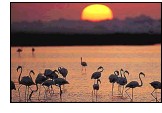Together for Doņana

The Doņana area is the habitat for 875 plant and 226 bird species, apart from fishes, reptiles, amphibians and protected mammals. Doņana is vital as an annual stop-over point for over 6 million migratory birds: Spoonbill, Greater Flamingo, Glossy Ibis, Avocet or the Greylag Goose are some of these species. Until 60,000 individuals from the last species feed and winter in this area, coming from the rest of Europe (Netherlands, Germany, Sweeden, Denmark, etc.). But Doņana also harbours the last surviving populations of the Iberian lynx (the world's most endangered feline) and of the Spanish Imperial Eagle, both species on the verge of extinction.
Doņana has been declared wetland of international importance having extraordinary ecological value by the Ramsar Convention, Biosphere Reserve (1980) and World Heritage Site (1994) by UNESCO. But Doņana is also under intense pressure from inappropriate development, particularly in the form of uncontrolled tourism, agriculture and road building.
WWF Spain and the European Freshwater Programme, with funds from WWF Netherlands and WWF UK and the support of EPO and MedPO, set out to establish a model project, lead by a three-person team working in partnership with local stakeholders. The aim was to establish Doņana as a model for ecological restoration, nature conservation and sustainable development .
More information:
- Together for Doņana (WWF)
Photo Š WWF/Jorge Sierra
Datum: 09/07/2001
© 1996-2024 BalearWeb / Mallorca - Werbung - Kontaktieren Sie uns - Zugelassene Informationen - Zugänglichkeit
